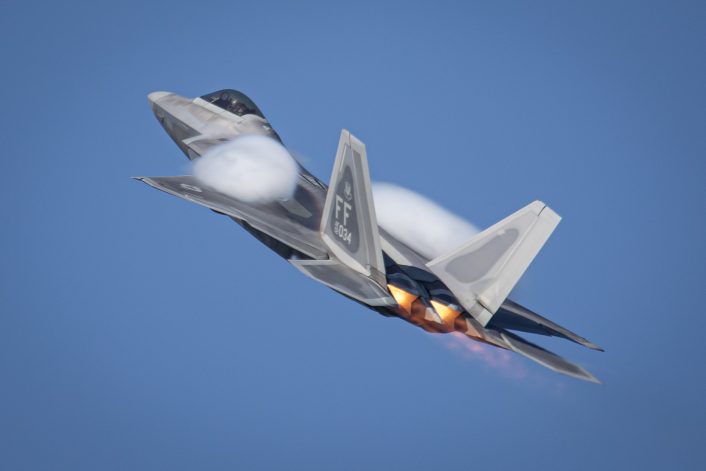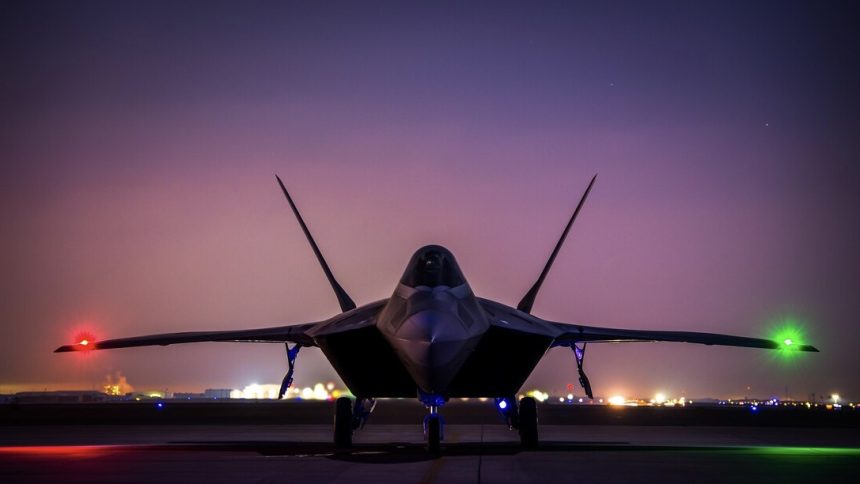Looking back at its first combat operations against ISIS, the F-22 proved it could do much more than dominate the skies, delivering precision strikes and sharing critical data with allied platforms across the battlespace.
Although primarily designed as an air dominance fighter, the fast super-maneuverable and stealthy F-22 also fills other roles, including precision air-to-ground attacks as well as providing situational awareness and data to other aircraft and weapon platforms in the battle using its advanced integrated avionics, and the Raptor utilized all of these strengths in its initial combat operations against ISIS in the Middle East.
The F-22 Raptor
In 1981 the United States Air Force (USAF) initiated the Advanced Tactical Fighter (ATF) program in order to acquire a replacement for the F-15 fighter. Following a period of developing specifications as well as concepts, a Request for Proposals (RFP) went out in Sept. 1985. Seven companies bid, with Lockheed and Northrop selected in 1986 to produce demonstrator prototypes. Lockheed teamed with Boeing and General Dynamics, with Northrop working with McDonnell Douglas. The efforts of teaming from these companies produced the Lockheed YF-22 and the Northrop YF-23, with the YF-22 chosen as the winner.

The production model was designated the Lockheed Martin F-22A Raptor, and incorporates stealth, agility, advanced integrated avionics, as well as performance in one package, along with the capabilities to conduct air-to-air and air-to-ground missions. The fifth generation fighter aircraft is able to track, identify, and engage air-to-air threats before being detected, using the AN/APG-77 Active Electronically Scanned Array (AESA) radar and AN/ALR-94 passive receiver system. Raptors can receive information from other F-22s in a manner that allows radar-silent attacks; an F-22 can track a target covertly and send target information to a Raptor closer to the target to engage it. The fused avionics facilitate situational awareness for the entire aircraft package that is involved in executing the mission.
Powered by two Pratt & Whitney F119-PW-100 engines, the Raptor can reach “supercruise” speeds of Mach 1.8 without using afterburners, with a top speed of Mach 2.25. Thrust vectoring, advanced aerodynamics and flight controls, combined with a high thrust-to-weight ratio give the aircraft excellent agility. The F-22 has a service ceiling of 65,000 ft. Length of the aircraft is 62 ft. 1 in., height 16 ft. 8 in., with a wingspan of 44 ft. 6 in. Maximum take-off weight is 83,500 lb.
Firepower includes one 20 mm M61A2 Vulcan rotary cannon with 480 rounds, up to six AIM-120C/D AMRAAM (Advanced Medium-Range Air-to-Air Missile), or four AIM-120A/B (Note: once the C variant was introduced, the typical loadout became three missiles mounted on each side within the main weapons bay), and two AIM-9M/X Sidewinder missiles. Missiles other munitions are carried in internal weapons bays to increase stealth capability, with external stowage available for both weapons and range-extending fuel tanks.
Ground attack mission loadout options include two 1,000 lb. Joint Direct Attack Munitions (JDAMs), and two AIM-120 missiles, or eight GBU-39 SBDs (Small Diameter Bombs) along with two AIM-120 missiles, and a third option consists of four GBU-39s and four AIM-120 missiles. Two AIM-9s would also be included with each loadout option in internal side weapon bays.
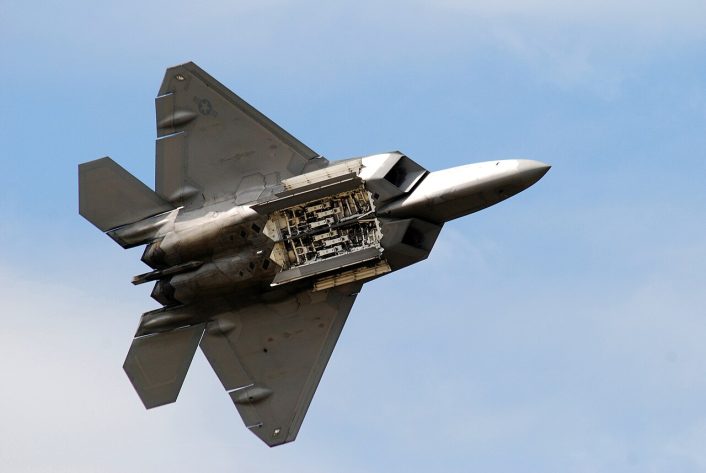
ISIS
Known as the Islamic State of Iraq and Syria (ISIS), the Islamic State of Iraq and the Levant (ISIL) or the Islamic State (IS) while occupying parts of Iraq, Syria, and other countries, the group declared itself to be a worldwide caliphate in 2014. Recognized by much of the world, including the United Nations, as a terrorist organization, by the end of 2015 the group ruled over a population of around 12 million. Estimates between 2014-2015 showed ISIS commanded up to 30,000 fighters and an annual budget of over 1 billion in United States dollars. Attacks were launched by the group that included genocide, brutal attacks on people of other faiths, aid workers, soldiers and even journalists; with ISIS often producing videos of beheadings. Cultural sites were destroyed and acts of terror carried out in territories outside the group’s control as well.
As far as arms go, ISIS has possessed various weapons from various sources. Many weapons came from Iraqi stockpiles with little or no oversight during turbulent times and corruption run unchecked that led to weapons being added to ISIS’s arsenal. These weapons have originated from the United States, Russia, China, Eastern Europe, and even the Soviet Union. A variety of small arms include the ubiquitous AK-47 rifle and its derivatives, as well as arms from the American M-16 family. Machine guns, pistols, and sniper rifles are also part of the small arms they possess. Portable air defense systems including surface-to-air missiles, anti-tank missiles, mortars, artillery, even armored fighting vehicles and a few aircraft found their way to the terrorist group. Improvised Explosive Devices (IEDs) and homemade chemical agents such as mustard and chlorine gas have also been reported to have been used.
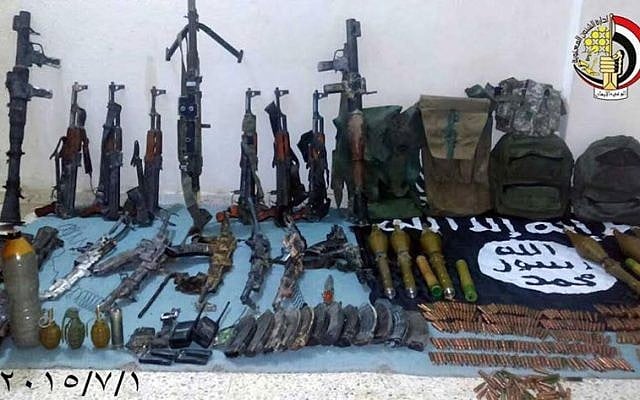
Operation Inherent Resolve
The F-22A Raptor received its baptism of fire against ISIS in an operation that became known to the U.S. Central Command (CENTCOM) as Operation Inherent Resolve. Beginning on Sept. 22, 2014, F-22s from the 27th Fighter Squadron of the 1st Fighter Wing from Langley-Eustis, Virginia began their first combat sorties during the opening of Operation Inherent Resolve in Syria. 1,000 lb. GPS-guided bombs hit an ISIS command and control center, and other targets were struck as well. The main purpose of Operation Inherent Resolve was to defeat ISIS in Syria and Iraq in conjunction with similar operations in Libya.
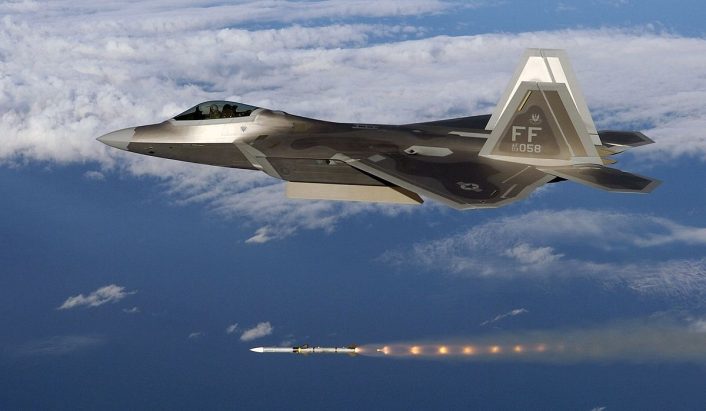
The F-22 would go on to fly 204 sorties during the time period between Sept. 2014 and July 2015, hitting 60 locations with a total of 270 bombs dropped. Raptors would conduct more than just surgical bombing strikes and Close Air Support (CAS) missions; they also used advanced avionics for surveillance dramatically increasing situational awareness and communicating target and battlefield information to other aircraft and weapon platforms and flew cover for other aircraft. The aircraft proved valuable not only as a fighter with ground attack capabilities, but also for its abilities to stealthily operate in contested airspace, gathering information and rapidly getting that information in the hands of decision makers. While ISIS had no air force to speak of, some analysts suggested the mere presence of F-22s deterred other forces in the region from launching air attacks against American allies such as Kurdish forces in the region as well.
While the F-22 faced a tumultuous beginning, has faced many challenges with budget cuts, teething problems, and cost overruns; the aircraft definitely made an impression during its first combat operations against ISIS.
During the recent conflict between Israel and Iran, and the U.S. strikes on Iran’s nuclear facilities, more F-22 Raptors were deployed to the Middle East region and took part in the raids.
While it remains an impressive combat aircraft, it is also a favorite of airshow spectators, demonstrating impressive maneuverability and speed.
